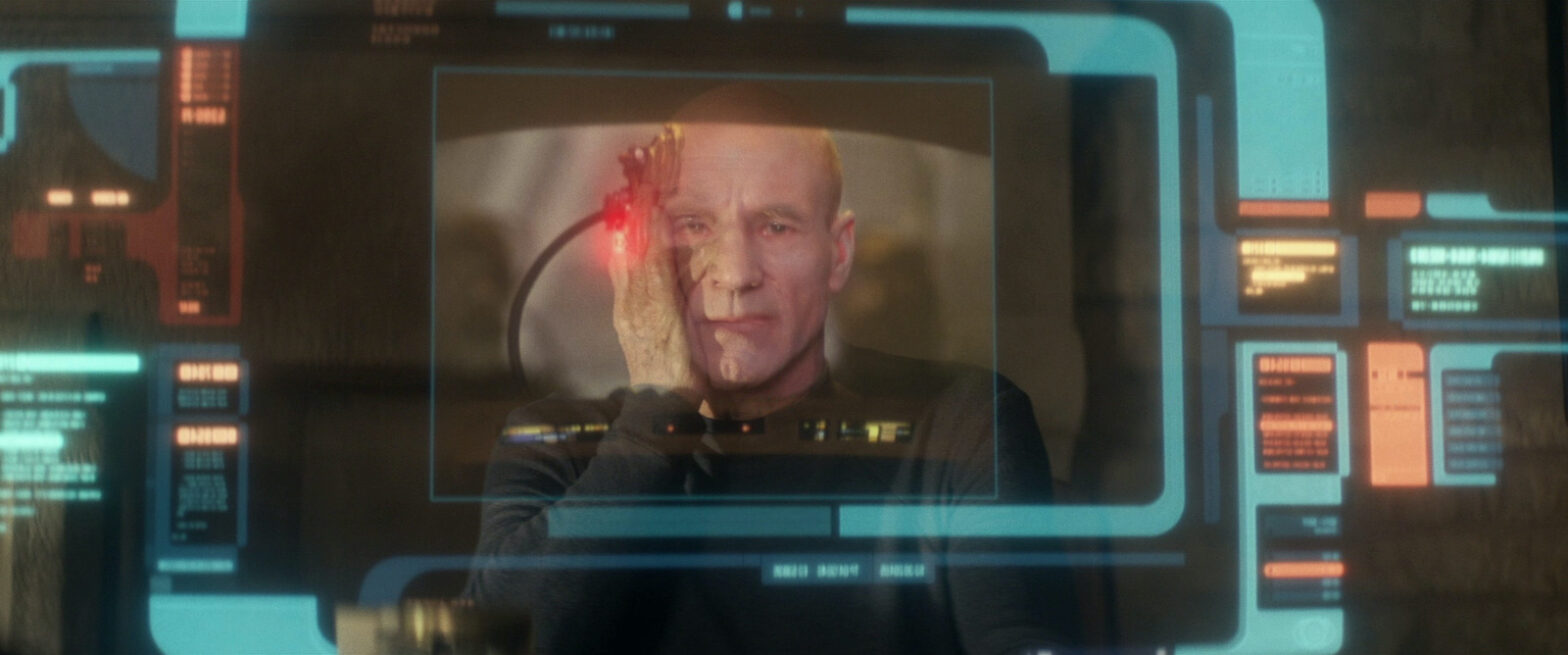“That’s not my name.”
In “The Impossible Box,” we arrive at what I’ve elsewhere described as ur-text of any modern Picard story: the now-seemingly-inevitable narrative debt to Locutus of Borg. “The Best of Both Worlds” gets trotted out for the umpteenth time as the defining trauma of Picard’s life, as Picard finally visits the Artifact Borg cube. This episode forms the bulk of season 1’s pass at the concept, but don’t worry: Picard’s Borg trauma will return, reliably, in seasons 2 and 3. Resistance may be futile, to coin a phrase; but doting on Locutus is apparently inevitable.
The Locutus of it all does lead to one thing that Picard (indeed, all modern Star Trek) otherwise doesn’t do very much of: great images. Image-based storytelling has never been much of a plank on Trek, other than the primary colour iconography of the spacemen themselves; you can count the number of lingering visuals from the entire franchise on a couple of hands. But “Impossible Box” director Maja Vrvilo gives that list a run for its money as Picard calls up a holographic image of Locutus and then, contemplating his “reflection,” instinctively reaches for his own cheek in an attempt to “feel” the implants that are no longer there, one image superimposed upon the other. It’s better than any storytelling about Picard’s post-traumatic stress than any Trek series or movie has done since “Family,” and it’s a wordless, five-second moment.
This is the “all hell breaks loose” episode, where, having run itself in circles since the premiere to delay arriving at this exact moment, Picard and Soji finally meet and go on the run together, in a manically-compressed five minutes at the end of the episode. Hugh Borg is back, and there’s an eerie moment as Picard is triggered by “helpful” XBs trying to keep him from falling off a Borg cube gantry (as in Star Wars, there are no railings in space, apparently). On a better-written show, a beat in the surgical theatre where Picard realizes that all Borg, not just him, are victims, would serve as a nice lynchpin of his entire arc with the villain species — and might force him to reconsider his earlier bloodthirstiness. Instead, the beat arrives too quickly, and is immediately forgotten, because whenever we meet up with Picard again next season, we’re going to have to do the Borg again too. Because Locutus is inevitable.
Elsewhere in the hour, Raffi is in the midst of a full-on addictive and mental health crisis, after her failed attempt to reconnect with her son last episode. Rather than helping her, the crew of La Sirena use her to gain illegal access to the Borg cube, and then tuck her into bed; if you ever felt like what was missing from your life was ample reason to actively hate Captain Picard, this is your episode. (He doesn’t just enable her addiction here; he applauds it, literally, when Raffi has successfully bamboozled Starfleet into giving the crew a pass to the Artifact.)
Right behind Raffi is Agnes, who murdered her ex-boyfriend last week and is this week having feelings about it, which she decides to wash away with a bit of casual sex with Rios — who may not know about Bruce’s murder, but certainly knows that Agnes is coming apart, and figures, “why not?” take her to bed anyway. And over on the Artifact, Romulan Fuckboi finally gets through the layers upon layers of Soji’s neural shielding by exploiting faux dreams she’s been having about a life as a little girl that she never lived. Yup, this is a whole-ass episode of the male characters abusing the mental health of the female characters for their personal gain, and pretty much all of it is played off as whacky shenanigans — a scoundrel crew just up to their usual scoundrel business. It’s fucking gross.
I gave Picard‘s first season a marginal pass when it aired. After rewatching the last three episodes, though, I’m no longer able to unsee the argument that this series is actively shitting all over the memory of Star Trek: The Next Generation, either through carelessness or malign intent, I don’t know (or care) which. How much does Patrick Stewart hate Jean-Luc Picard? There are, of course, two theories: 1/ a lot, or 2/ the more plausible: he doesn’t, but he’s not qualified to do the job of producing stories about him. Never, ever let an actor get creative control over his character, because being good at one thing does not mean you’re any good at something else. Patrick Stewart is generally a stalwart, capable actor — but he’s an awful creative exec.
Blogging the Next Generation: Picard runs Thursdays on tederick.com as I work my way through every episode of Star Trek: Picard. The original BTNG did the same for Star Trek: The Next Generation.
